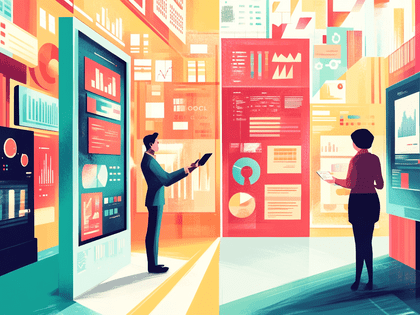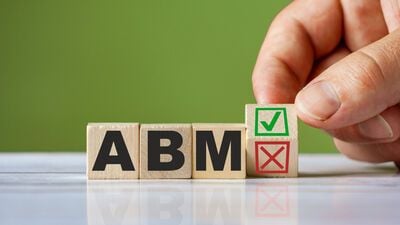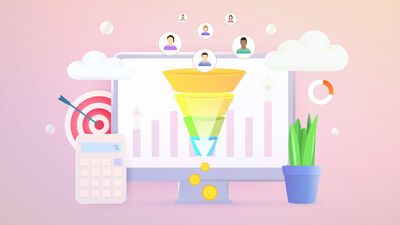Flipping the B2B Funnel with Account-Based Marketing (ABM) vs. Traditional Marketing

- ABM begins by targeting high-value accounts, not building broad awareness.
- Engagement is personalized early, replacing generic content with direct outreach.
- Conversion is trust-driven, aligning sales and marketing from day one.
- Growth happens after the close, scaling through upsells and similar accounts.
- ABM favors precision and impact over lead volume and ad spend.
- Together, these shifts make ABM a long-term growth engine, not a short-term tactic.
Over 70% of B2B marketers at mid-to-large companies plan to launch Account-Based Marketing (ABM) strategies. Because it works!
ABM has proven to deliver higher ROI and shorten complex B2B sales cycles. But while many teams plan for it, few move beyond the planning stage. Why? It seems hard to implement, or is it?
In this article, we break down the real differences between ABM vs. traditional marketing funnels, based on our Growth Gears podcast conversation with our fractional CMOs here at O8. If you're stuck between intention and execution, these insights will help you flip your B2B funnel and close high-value accounts.
What Is Account-Based Marketing (ABM)?
Account-Based Marketing (ABM) is a B2B marketing strategy that starts with the identification of high-value accounts, not volume.

Instead of pushing inbound marketing to a broad audience and waiting to see who bites, an ABM campaign flips the traditional marketing funnel:
You identify a list of high-value accounts you want to close, and build everything around them from day one.
Your leads are all but a handful of decision-makers at companies you’ve handpicked based on revenue potential, industry, or buyer intent. And that shift, from hoping for leads to targeting specific accounts, is what makes the ABM strategy fundamentally different in B2B marketing.
In our podcast, we called this a funnel flip. Traditional lead generation starts with awareness and narrows down. The ABM strategy starts at the bottom of the funnel, with clear targets, and works backward to create personalized, relevant engagement.
It’s a strategy that demands focus, alignment, and often, a tighter partnership between sales and marketing teams. But when it’s done right, the impact is measurable: higher ROI, stronger relationships, and faster-moving sales cycles.
What Is Traditional B2B Marketing?
Your traditional B2B marketer focuses on volume-driven marketing efforts, building awareness through broad campaigns, and narrowing down leads over time. You cast a wide net using digital marketing, content marketing, webinars, traditional advertising, social media campaigns, and email funnels to generate demand.
This approach is built on reach, visibility, and scale. It works well for demand generation and capturing interest across a broad audience, especially when targeting diverse or unknown buyers.
But while traditional B2B marketing is efficient at filling the top of the funnel, it can waste time on low-fit leads and often lacks the precision and alignment ABM offers.
Key Differences Between ABM and Traditional Marketing Funnels

Many revenue team leaders mistake account-based marketing for a set of tactics layered onto existing funnels. But an ABM campaign is more than that, reversing the entire marketing funnel.
Precision Targeting
ABM doesn’t aim for mass outbound marketing or brand awareness via content marketing. It starts by identifying high-value accounts and tailoring campaigns specifically to them. Instead of marketing to everyone and qualifying later, you focus from the start, improving efficiency and reducing waste.
Efficiency and Alignment
By concentrating efforts on a defined account list and a very specific and shortlisted target audience, ABM naturally aligns both the sales and marketing teams around the same goal. Every message, touchpoint, and offer is built for accounts that actually matter, driving higher conversion rates and tighter team collaboration.
This approach works; 83% of marketers report increased engagement with target accounts when using ABM strategies. Below, we'll go through four fundamental shifts that redefine ABM vs traditional marketing funnels.
1- The A/B Marketing Funnel Starts with Identification, Not Awareness

In traditional B2B marketing, the process starts wide: build brand awareness, drive traffic, and hope that your Ideal Customer Profile turns into a real human and raises their hand. It’s a volume game, your marketing efforts aim to generate as many leads as possible and qualify them later.
But in ABM, the funnel is flipped. You don’t wait for the right accounts to show up; you choose them upfront.
Strategic Targeting, Not Spray and Pray
ABM begins by selecting a focused list of high-value accounts based on revenue potential, intent signals, industry relevance, or organizational fit.
Identifying New Account Groups
This targeting doesn’t stop with net new business. One of the most overlooked ABM growth levers is segmenting existing clients into new account groups. A leadership change, new initiative, or acquisition can create opportunities to pitch services that were previously off the table.
In our Growth Gears episode, we shared how recognizing a shift in leadership at a current client helped us reposition our offering and deliver additional value, unlocking a whole new growth path without having to win a new logo.
Why This Flip Matters
This shift from “attract whoever clicks” to “engage the right people from the start” increases efficiency, reduces wasted spend, and ensures your team is aligned on accounts that matter most.
“In ABM, instead, you're handpicking specific companies—kind of target accounts—and then decision-makers within those accounts or buying groups based on fit, you know, revenue potential, industry, things like that, potentially some buying intent data. So you're really being laser-focused on who you want to bring in as an account rather than the opposite.”
2- Interest Stage in the ABM Funnel: Personalizing Outreach and Engagement

One of the biggest differences I see in ABM vs traditional marketing campaigns is how we approach the engagement or the interest stage.
In traditional B2B marketing, this is where any marketing team keeps dropping content: blogs, webinars, landing pages, eBooks, anything to generate interest at scale. The hope is that someone bites, then you score them, segment them, and start nurturing.
But in strategic ABM, a B2B marketer is not trying to hook a crowd, we’re going straight to the people we want to work with, targeting specific high-value accounts.
“We’re not casting bait. We’re knocking on the door of specific accounts with a custom-tailored solution they already need.”
That’s the difference. Engagement in ABM is built around personalized outbound marketing: direct emails, 1:1 LinkedIn messages, custom demos, or even short video walkthroughs built just for that company. You’re not waiting for form fills, you’re initiating the relationship intentionally.
Zachary made a great point in that conversation: this kind of outreach takes more SDR-level effort. It’s not passive. But the return is higher because the person on the receiving end can actually tell it was made for them.
Of course, there’s a learning curve. A lot of teams hit an ABM “hype cycle” they’re excited at first, but hit a wall when they realize ABM takes persistence, collaboration, and a shift in how success is measured.
ABM effort isn’t softer. It’s smarter. And it’s built to connect, not just convert. Shifting from broad content pushes to tailored outreach is what makes an ABM campaign so effective.
When your engagement is built around the real needs of high-value accounts, your digital marketing efforts become sharper, your conversion rates improve, and you start building relationships that actually last. That’s the difference: ABM isn’t about more content. It’s about more connection.
3- Conversion Stage: Conversion Starts with Trust, Not Just Timing
In traditional marketing methods for lead generation, conversion tends to be reactive. A lead fills out a form, hits a score threshold, and gets passed to sales. But by then, the window may have already closed, or they were never the right fit to begin with.
With an ABM strategy, the focus shifts. You’re working with pre-qualified high-value accounts from the start. Sales and marketing align early, not at the handoff stage. And instead of tracking MQLs, you’re watching real engagement signals, site visits, demo views, email replies, and content consumption across the buying group.
“You already know they’re a fit. Now it’s about building trust and relevance until they’re ready to move.”
This shift demands new metrics. You’re not measuring form fills, you’re measuring sales cycle progression, meeting quality, and multi-threaded engagement.
“If you can schedule even a 15-minute meeting with a C-level contact at one of your top accounts, that’s a win.”
- Zachary Ellison, CMO, O8
The real value of ABM is that you’re not chasing leads anymore, or doing “demand generation,” you’re earning conversations with the right people, highly potential customers, at the right time.
This kind of conversion only happens when sales, marketing, and even service teams are aligned from the start. Everyone’s working the same accounts, sharing insights, and driving toward the same outcome.
And the KPIs reflect that, engagement, awareness, and intent, not just leads.
Importance of Cross-Team Collaboration
Unified Efforts
ABM only works when sales, marketing, and even service are moving in sync. Everyone’s focused on the same high-value accounts, sharing intel, and shaping outreach together. That shared ownership is what gets result; 66% of top-performing companies run ABM across multiple departments.
Example of Teamwork
When sales and marketing are aligned, every message hits harder. From first touch to close, the account gets a consistent, relevant experience—and that makes it easier to build real trust across the buying committee.
New Metrics for Success
Beyond Leads
Traditional funnels track MQLs. ABM tracks account engagement and awareness: Do they know who we are? Are they interacting?
Measuring Engagement
The signals look different: clicks on a custom email, time on site, repeat visits to key content. These data points help teams adjust messaging in real time and stay relevant while trust builds.
Most B2B teams struggle with scattered marketing. This quiz shows what to fix first.
4- Scaling with ABM After the Win

Once you’ve secured an account, the journey doesn’t end there. In account-based marketing, scaling happens after the initial win by focusing on expanding the relationship and leveraging successful strategies to replicate wins with similar accounts.
Building on Success
Upselling and Cross-Selling
After closing an account, ABM shifts the focus to upselling and cross-selling within that account. You’ve already built a foundation of trust, so it’s a logical step to introduce additional services or products that can further benefit the client.
For example, if you’ve implemented a software solution, you might offer additional modules or premium services that enhance their current setup.Using Proven Strategies and Best Practices
The insights and data collected during the initial engagement are invaluable. With a clear understanding of what strategies led to success, you can refine and replicate these approaches for similar accounts.
This involves targeting new accounts with a demonstrated need for your solutions, using the success story as a compelling case study.
Targeting Similar Accounts
Once you have a successful case with one client, it serves as a strong proof point. You can approach other companies in the same industry and say, “Here’s how we helped Company X achieve great results. We can do the same for you.”
This strategic approach not only leverages your existing success but also helps build credibility and trust with new potential customers in your target audience.
By focusing on expansion after securing a win, ABM enables companies to maximize the value of each account and create a scalable growth model. This approach not only increases revenue but also strengthens client relationships through continued trust and success.
“In ABM, after closing an account, you scale by upselling within that account or targeting similar accounts… growth is building from success.”
- Seth Viebrock, CEO, O8
How to Manage Long B2B Sales Cycles
B2B sales cycles and complex deals with multiple stakeholders, long decision timelines, and evolving scopes require a different type of patience.
Understanding the Process
In case you need another reminder, on average, B2B sales cycles last 84 days, and 63% of buyers need at least three touchpoints before making a decision. These numbers reflect the importance of persistence and proper expectation-setting.
Building Momentum
ABM teaches you to value progress. Booking a 15-minute meeting with a key stakeholder? That’s traction. Securing a soft commitment for a pilot? That’s a step forward. Celebrate those momentum, they’re signs your account engagement strategy is working.
“If you can schedule even just a 15-minute meeting with a C-level person for your top account... that’s a huge win and something to refine upon.”
– Zachary Ellison, CMO, O8
Consistency is Key
Deals don’t stall because people say no. They stall because they forget. Stay on their radar—with insights, relevant check-ins, or simple nudges that keep your team top-of-mind. This is where digital marketing and marketing automation can keep the cadence going without burning out your sales team.
Top 5 Advantages of ABM vs. Traditional Marketing

Both Account-Based Marketing (ABM) and traditional B2B marketing aim to generate revenue, but they approach it in fundamentally different ways. Traditional marketing casts a wide net, prioritizing reach and awareness. ABM takes a targeted, relationship-first approach that aligns closely with sales strategy and long-term growth goals.
Here’s where ABM pulls ahead:
Efficiency in Targeting
Traditional marketing often spends heavily on digital marketing and inbound campaigns that generate a high volume of leads, but many of them will never convert. ABM flips that model: you start with high-value accounts that already match your ICP, making every marketing effort more focused and more likely to convert.
Sales and Marketing Work as One
Where traditional marketing typically operates in silos, handing off leads to sales when they’re “ready,” ABM aligns both teams from the beginning. Marketing isn’t just generating interest; it’s creating personalized campaigns in sync with the sales team’s outreach.
This collaboration helps shorten the sales cycle and ensures a consistent, relevant experience across every touchpoint.
Trust Comes Before the Close
In ABM, conversion isn’t the end goal, it’s part of a longer relationship arc. Building trust happens early through consistent outreach, tailored offers, and ongoing value.
Traditional marketing, by contrast, often focuses on quick-win conversions without establishing a deeper connection. ABM plays the long game, and it wins because of it.
Better Tools for Smarter Growth
ABM marketing thrives on real-time insights. With marketing automation and engagement tracking tools, teams can monitor account behavior, adjust messaging based on actual activity, and continuously optimize.
Traditional models tend to rely on surface-level KPIs like traffic or downloads. ABM gives you strategic data you can act on.
Growth That Scales from Success
Traditional marketing scales through reach: more ads, more content, more impressions. ABM scales through relevance. Once you’ve closed a target account, you refine what worked and use it to win others like it. Every success becomes a repeatable case study. You’re not starting from scratch, you’re stacking wins.
Conclusions
A successful account-based marketing strategy doesn’t rely on blasting messages to a broad audience or chasing short-term wins. It thrives on focus, precision, and meaningful engagement with high-value accounts.
The difference between ABM vs traditional marketing lies in the ability to build trust, align marketing teams with sales teams, and use real engagement metrics to shape smarter, long-term strategies.
When you lead with personalization, track progress beyond leads, and scale through trusted relationships, you’re not just filling a funnel, you're building a growth engine. The most effective B2B marketing strategies are targeted, data-informed, and grounded in what actually works, not what sounds good.
Want more insights like this?
Listen to the full episode and subscribe for expert perspectives on aligning your teams for growth. Or browse all our episodes here.
O8 Helps You Align Your Marketing with Real Goals
We’ll help you cut through the noise, spot what matters, and fix what’s holding back results.








